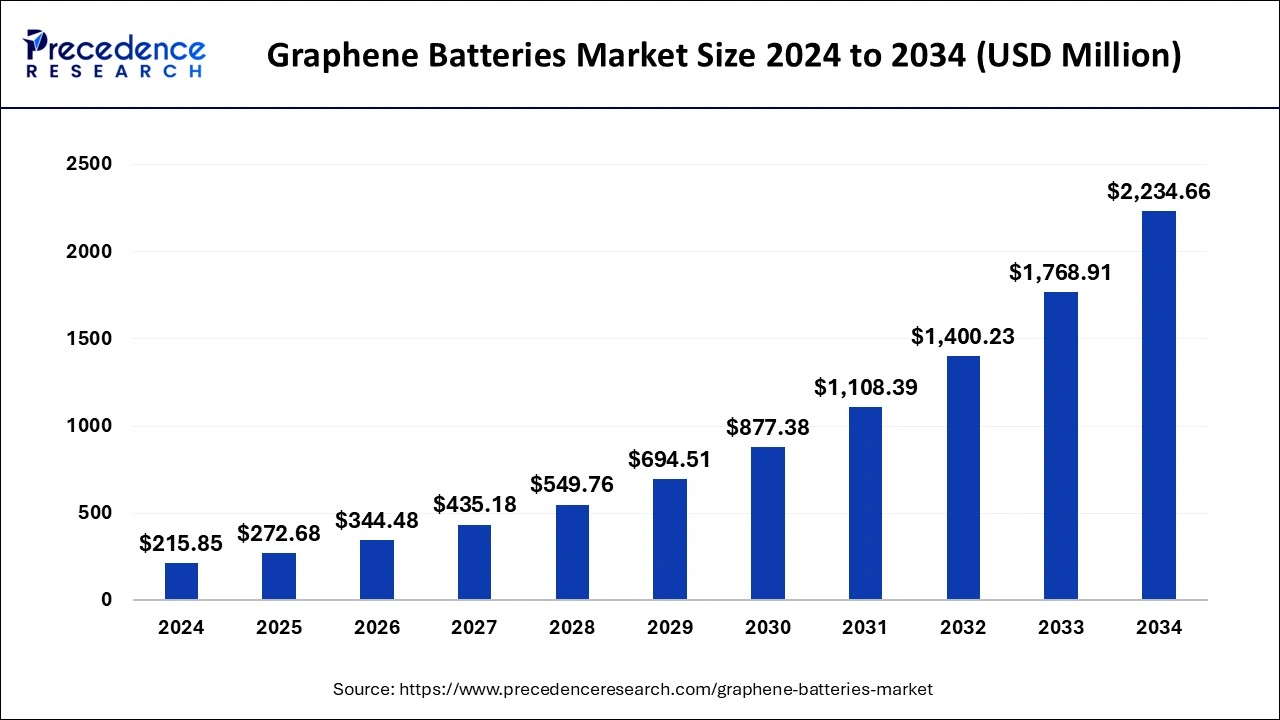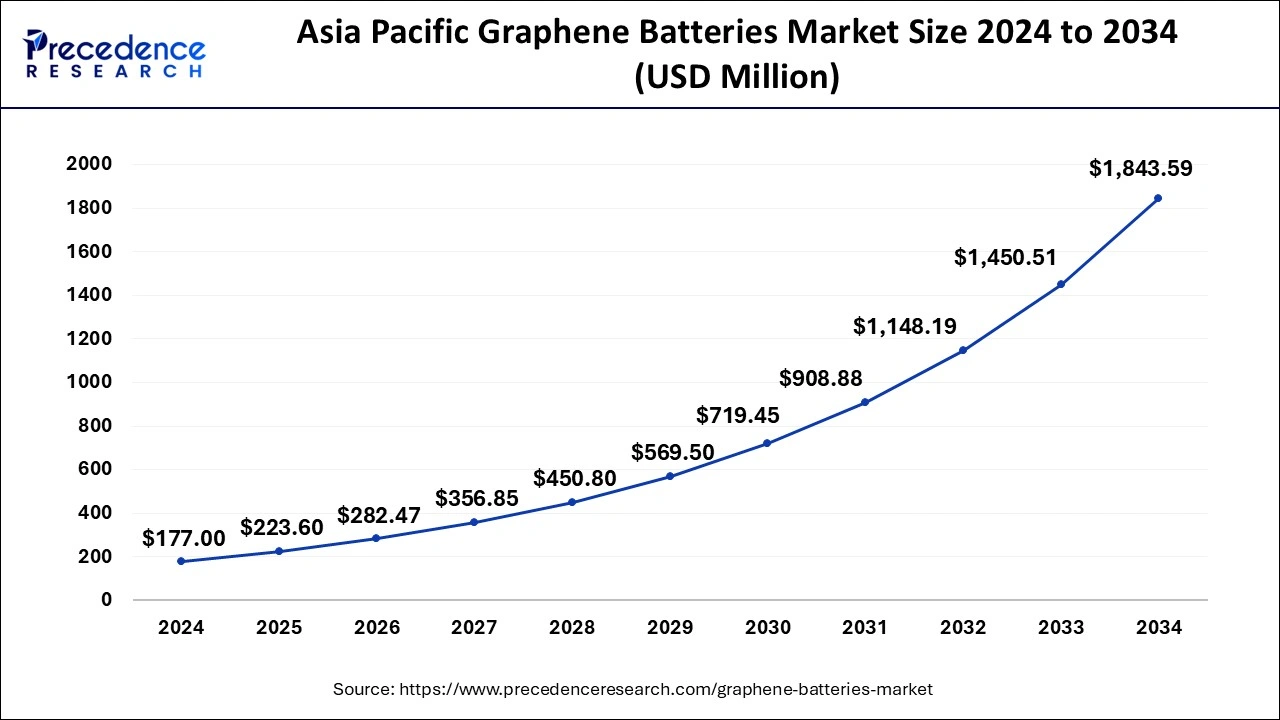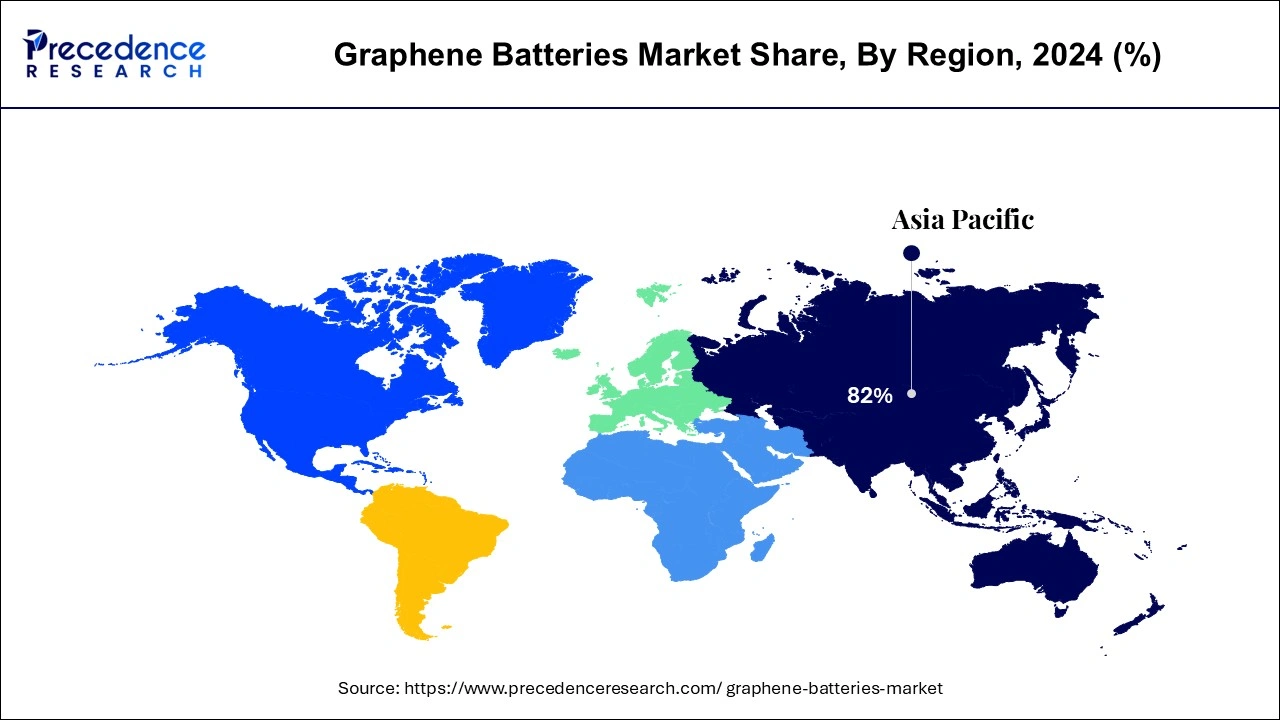November 2024
The global graphene batteries market size is calculated at USD 272.68 million in 2025 and is forecasted to reach around USD 2,234.66 million by 2034, accelerating at a CAGR of 26.33% from 2025 to 2034. The Asia Pacific graphene batteries market size surpassed USD 223.60 million in 2025 and is expanding at a CAGR of 26.41% during the forecast period. The market sizing and forecasts are revenue-based (USD Million/Billion), with 2024 as the base year.
The global graphene batteries market size was estimated at USD 215.85 million in 2024 and is predicted to increase from USD 272.68 million in 2025 to approximately USD 2,234.66 million by 2034, expanding at a CAGR of 26.33% from 2025 to 2034. The drivers propelling the graphene batteries market include increasing demand for high-performance energy storage solutions, especially in electric vehicles and consumer electronics, alongside advancements in research and development efforts aimed at optimizing battery performance and scalability for widespread commercial adoption.

The asia pacific graphene batteries market size was evaluated at USD 177.00 million in 2024 and is predicted to be worth around USD 1843.59 million by 2034, rising at a CAGR of 26.41% from 2025 to 2034.

Asia Pacific dominated the global graphene batteries market in 2024. This dominance is driven by factors such as rapid industrialization, technological advancements, and the presence of key players in the region. Countries like China, Japan, and South Korea are at the forefront of graphene battery development and deployment. China, in particular, leads the market due to its robust manufacturing infrastructure, significant investments in research and development, and supportive government policies promoting innovation and clean energy technologies. The region’s strong focus on electric vehicles, consumer electronics, and renewable energy further boosts the demand for graphene batteries, positioning Asia Pacific as the largest market globally.

Europe is estimated to expand at the fastest CAGR between 2025 and 2034. Countries like Germany, the United Kingdom, and France are driving the growth in Europe, leveraging their technological expertise, strong industrial base, and commitment to sustainability. The European Union’s ambitious targets for reducing carbon emissions and promoting renewable energy sources have spurred investments in graphene battery technology across various sectors. Additionally, collaborations between academic institutions, research organizations, and industry players have facilitated advancements in graphene battery research and development in Europe, further contributing to the region’s position as a key player in the global graphene batteries market.
Graphene batteries, a revolutionary advancement in energy storage technology, are gaining significant traction in various industries due to their exceptional properties. Graphene, a single layer of carbon atoms arranged in a hexagonal lattice, provides batteries with superior conductivity, lightweight structure, and high surface area. These batteries offer faster charging times, longer lifespan, and increased energy density compared to traditional lithium-ion batteries, making them an attractive option for electric vehicles, consumer electronics, and renewable energy storage systems.
The global graphene batteries market is experiencing rapid growth, driven by increasing demand for efficient and sustainable energy storage solutions. With ongoing research and development efforts focused on enhancing graphene battery performance and scalability, the market is poised for significant expansion in the coming years. Additionally, favorable government initiatives promoting clean energy adoption and rising environmental concerns are further propelling the adoption of graphene batteries worldwide.
The graphene batteries market is investing heavily in innovation and strategic partnerships to gain a competitive edge and capture a larger market share. Collaborations between research institutions, battery manufacturers, and graphene suppliers are fostering advancements in battery technology and driving down production costs. As graphene batteries continue to evolve and become more commercially viable, they are expected to revolutionize the energy storage landscape and contribute to a more sustainable future.
The graphene batteries market is experiencing robust growth propelled by several key factors. Firstly, the remarkable properties of graphene, including its high conductivity, lightweight nature, and large surface area, make it an ideal material for improving battery performance. Graphene enhances energy storage capacity, enables faster charging times, and extends battery lifespan, addressing the demand for more efficient and durable energy storage solutions across various industries.
The increasing demand for electric vehicles (EVs) is a significant growth factor for the graphene batteries market. As the automotive industry shifts towards electrification to reduce carbon emissions and dependence on fossil fuels, there is a rising need for advanced batteries with higher energy density and faster charging capabilities. Graphene batteries offer a promising solution to meet these requirements, driving their adoption in EVs and electric mobility applications.
Increasing investments in research and development (R&D) activities are accelerating the commercialization of graphene batteries. Major players in the battery industry, as well as academic and research institutions, are investing in exploring the potential of graphene-based materials to overcome existing limitations in battery technology. These investments aim to optimize manufacturing processes, enhance battery performance, and scale up production to meet growing market demand.
The graphene batteries market is propelled by the unique properties of graphene, the growing demand for electric vehicles and consumer electronics, and investments in R&D initiatives. As graphene battery technology continues to advance and become more cost-effective, it is expected to play a pivotal role in shaping the future of energy storage and powering the transition towards a greener and more sustainable world.
| Report Coverage | Details |
| Growth Rate from 2025 to 2034 | CAGR of 26.33% |
| Market Size in 2025 | USD 272.68 Million |
| Market Size by 2034 | USD 2,234.66 Million |
| Largest Market | Asia Pacific |
| Base Year | 2024 |
| Forecast Period | 2025 to 2034 |
| Segments Covered | By Type and By End-use |
| Regions Covered | North America, Europe, Asia-Pacific, Latin America, and Middle East & Africa |
Demand for high-performance energy storage solutions
The increasing demand for high-performance energy storage solutions across various industries is a primary driver of the graphene batteries market. Graphene’s exceptional properties, including high conductivity, lightweight structure, and large surface area, make it an attractive material for enhancing battery performance.
As industries seek more efficient and durable energy storage options, graphene batteries offer solutions with faster charging times, longer lifespan, and higher energy density compared to conventional lithium-ion batteries. This demand is particularly evident in the electric vehicle (EV) sector, where automakers are increasingly adopting graphene batteries to improve driving range, charging efficiency, and overall performance.
Advancements in research and development (R&D)
Another key driver of the graphene batteries market is the continuous advancements in research and development (R&D) activities focused on improving graphene battery technology. Major players in the battery industry, along with academic and research institutions, are investing significant resources in exploring the potential of graphene-based materials to overcome existing limitations in battery technology. These R&D efforts aim to optimize battery manufacturing processes, enhance energy storage capacity, and reduce production costs. As a result, graphene batteries are becoming increasingly viable for commercial applications, driving their adoption across various sectors and contributing to the growth of the overall market.
Cost and scalability challenges
One of the primary restraints for the graphene batteries market is the cost and scalability challenges associated with graphene production and battery manufacturing. Graphene, although highly desirable for its exceptional properties, is still relatively expensive to produce on a large scale. Additionally, integrating graphene into battery manufacturing processes requires significant investments in infrastructure and technology. These cost barriers make graphene batteries more expensive than traditional lithium-ion batteries, limiting their adoption, especially in price-sensitive markets such as consumer electronics and grid-scale energy storage.
Advancements in EV technology
The rapid growth of the EV market presents a significant opportunity for the graphene batteries market. As governments worldwide implement stricter emissions regulations and consumers increasingly prioritize sustainability, the demand for EVs is on the rise. Graphene batteries offer several advantages over traditional lithium-ion batteries, including faster charging times, longer lifespan, and higher energy density. These features address critical concerns of EV manufacturers and consumers, such as range anxiety and charging infrastructure limitations. As EV technology continues to advance and battery requirements become more stringent, graphene batteries are well-positioned to capitalize on this growing market segment.
Integration with renewable energy systems
Another promising opportunity for the graphene batteries market lies in their integration with renewable energy systems, such as solar and wind power. The need for efficient energy storage solutions becomes increasingly critical as the world transitions towards a more sustainable energy mix. Graphene batteries can store excess energy generated from renewable sources during peak production periods and discharge it when demand is high or when renewable energy generation is low. This helps mitigate the intermittency and variability associated with renewable energy sources, improving grid stability and reliability.
Graphene batteries can be deployed in off-grid applications, such as remote areas or disaster relief efforts, where access to traditional power sources is limited. By leveraging graphene batteries in renewable energy systems, stakeholders can optimize energy management, reduce reliance on fossil fuels, and accelerate the transition toward a low-carbon future.
Capitalizing on these opportunities will require collaboration and innovation across various sectors, including battery manufacturing, automotive, renewable energy, and energy storage. By harnessing the unique properties of graphene and exploring new applications, stakeholders can unlock the full potential of graphene batteries and drive their adoption in emerging markets, ultimately contributing to a more sustainable and resilient energy ecosystem.
The lithium-ion graphene battery segment held the largest market share in 2024. Lithium-ion batteries incorporating graphene offer improved performance characteristics such as higher energy density, faster charging times, and enhanced cycle life compared to conventional lithium-ion batteries. These advantages make them the preferred choice for various applications, including consumer electronics, electric vehicles, and energy storage systems. Additionally, the maturity of lithium-ion technology and the existing infrastructure for production and deployment contribute to its dominance in the market, attracting significant investment and driving further innovation.
The automotive segment dominated the market in 2024. The automotive sector stands as a dominant segment in the graphene batteries market due to the increasing demand for electric vehicles (EVs) and the need for advanced energy storage solutions. Graphene batteries offer significant advantages over traditional lithium-ion batteries, including faster charging times, longer lifespan, and higher energy density. These features address critical challenges faced by the automotive industry, such as range anxiety and infrastructure limitations, making graphene batteries an attractive option for EV manufacturers. Moreover, the push towards stricter emissions regulations and sustainability goals further accelerates the adoption of graphene batteries in electric vehicles, driving growth in the automotive segment of the market.
The consumer electronics segment is expected to expand at the fastest rate over the projected period. This growth is attributed to the continuous demand for high-performance and long-lasting battery solutions. With consumers seeking devices with longer battery life and faster charging capabilities, graphene batteries offer a compelling solution to meet these requirements.
The incorporation of graphene in consumer electronics such as smartphones, laptops, and wearable devices enables manufacturers to deliver products with improved performance and enhanced user experience. As consumer preferences continue to evolve towards more efficient and sustainable technologies, graphene batteries are expected to maintain their dominance in the consumer electronics segment, driving innovation and market growth in this space.
By Type
By End-use
By Geography
For inquiries regarding discounts, bulk purchases, or customization requests, please contact us at sales@precedenceresearch.com
No cookie-cutter, only authentic analysis – take the 1st step to become a Precedence Research client
November 2024
July 2024
August 2024